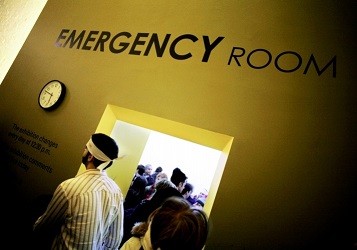By: Dr. Geoffrey Modest
A recent study tested the hypothesis that it might be useful to initiate buprenorphine/naloxone treatment in the emergency room for patients with opioid dependence (see JAMA. 2015;313(16):1636-1644).

Details:
–329 opioid-dependent patients coming into a large urban teaching hospital emergency department in New Haven CT (mean age 31, 76% men, 75% white/7% black/16% hispanic, 41% high school grads/41% with at least some college, 52% full time employed, 32% with private or commercial insurance, 55% going to private physician or clinic for care. 34% came to ED seeking opioid treatment. 25% used only prescription opioids, 53% reported IV drug use. 88% smoked cigarettes, 55% used cocaine, 53% cannabis and 47% sedatives. alcohol use to the level of intoxication in 1/3 of the sample. >50% with prior psych treatment.
–Randomized to referral group (screening and refer for treatment); brief intervention (screening, brief intervention, and facilitated referral to community-based treatment service), or buprenorphine (screening, brief intervention, ED-initiated treatment with buprenorphine/naloxone, and followed frequently, about 1x every 1-2 weeks, in the hospital’s primary care center, then transferred at 10 weeks to either a community program or primary care clinic or were offered a 2-week detox program)
Results:
–Primary outcome (enrollment in and receiving addiction treatment 30 days after randomization): 78% of the buprenorphine group (89 of 114); 37% in the referral group (38 of 102); and 45% in the brief intervention group (50 of 111), (p<0.001)
–Secondary outcomes
–number of days of self-reported illicit opioid use/week: buprenorphine: decreased from 5.4 to 0.9; referral: decreased from 5.4 to 2.3; brief intervention: decreased from 5.6 to 2.4. (also p<0.001 for both time and intervention effects)
–-rates of urine tests which were negative: no difference between groups, all in the 43-58% range
–rates of HIV risk: no difference
–use of inpatient addiction treatment services: 11% in buprenorphine, 37% in referral, and 35% in brief intervention groups (p<0.001)
–post-hoc analysis: no difference in outcome if look at subgroup who came to the ED seeking opioid treatment
A timely study, given the just-released Massachusetts report of >1000 opioid-related deaths in 2014. this study has limitations in terms of its generalizability, with its short-term followup (though they argue that this short-term followup is the one that really tests the role of the ED in identifying and getting patients into care, but it would be best to see longer term results anyway), and there needs to be lots of systems developed to be able to replicate the study (establishing a consistent screening system in the ED, training providers in buprenorphine prescribing, having sufficient and accessible referral facilities in the community, having systems to bring patients into care within a few days of the ED visit, etc). So, it would be important to replicate this study elsewhere. but I am really impressed with buprenorphine as a medication that can really give motivated patients back their lives. I would estimate that at least 50% of my patients do fantastically (remain illicits-free, have relationships/jobs, can attend to their other med problems such as hepatitis C, etc). another 30+% have some problems staying completely off illicits, but are doing well/are very functional on buprenorphine, and a small percentage either drop out or need a more structured methadone program. And, I would agree with the study authors, giving buprenorphine in the ED setting is not fundamentally different from starting someone with concerning hypertension or hyperglycemia with appropriate drugs, and, as with buprenorphine as well, reinforces to the patient that we are taking this issue very seriously and it should have prompt treatment.